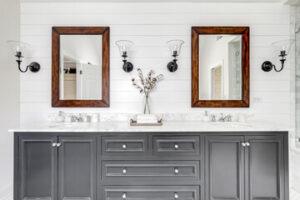Landscaping Springdale AR is the art of creating beautiful and functional outdoor spaces. It requires creative talent, technical skill, and an understanding of how different elements work together.

Hardscaping is the nonliving components of a landscape, such as patios and walkways. Landscapers use a variety of materials to construct these features.
Whether they contain flowers, vegetables or shrubs, planting beds can enhance your home’s landscape and create focal points for your yard. Beds can be created around driveways, patios and other features as well as in the center of your yard. They can be raised and contained with wood boards, stones or hedging for a formal look or left natural with a wavy, curved edge. The design of the bed itself is largely up to you, though many gardeners prefer to use a combination of plants for visual interest and ease of maintenance.
The first step in prepping a new planting bed is to kill any existing vegetation. Then the area can be worked up by hand, with a rototiller or a sod cutter. The resulting soil should be tested before any organic material is added, so that any necessary additions of limestone or fertilizer can be made.
A good soil is the key to a successful flower or vegetable garden. In addition to the proper pH level, a garden needs to be rich in organic matter. The best way to accomplish this is by adding organic mulches such as hay, straw or wood chips. These help suppress weed growth, retain moisture and moderate soil temperatures.
If the bed will be mainly for flowers, select varieties that bloom in winter, spring, summer and fall. Some perennials and bulbs will even thrive during the coldest weather. If the bed will have some shade, choose ferns, hollyhocks or yarrow to add texture and color.
When working with a bed that already contains established plants, it can be trickier to ensure the health of the existing foliage. It’s a good idea to dig up the grass and soil in the bed and mix in the recommended amounts of organic matter, limestone and fertilizer, however.
With careful planning and hard work, a beautiful, productive landscape can be yours. Remember to plan ahead and use the elements of nature as your inspiration for a beautiful, welcoming space that you’ll be proud to show off to friends and neighbors.
Lawns
Lawns are a cultural phenomenon that have been deeply embedded in our society through generations of social, economic and environmental forces. This has resulted in the societal expectation for green, perfectly manicured grass lawns – an ideal that carries with it many negative environmental consequences. Transitioning away from this outdated norm towards environmentally responsible landscaping practices is essential for conserving biodiversity, mitigating climate change, and promoting ecological health.
Grass is not only visually pleasing, but it also provides many environmental benefits. Unlike paved surfaces that reflect and absorb heat, grasses and other natural vegetation provide a cooling effect through a process called evapotranspiration. This keeps air temperatures lower, which reduces energy use for air conditioning. Lawns are also a source of oxygen and can filter and trap dust and pollutants, improving indoor air quality.
In addition to providing a cool, pleasant outdoor environment, lawns help prevent stormwater runoff and soil erosion. They can reduce sediment in streams and water bodies, and they can reduce the acidity of rainfall to one-tenth of its original level. They also attract and support pollinators, flora and fauna that promote local ecosystem health and stability.
A lawn is not just a beautiful yard feature; it can also be an asset for your home’s resale value. Potential buyers look for a well-maintained yard that is full of vibrant plants and aesthetically appealing. They want to be able to enjoy the outdoors without worrying about upkeep and maintenance, so lawns are an important factor in increasing home resale value.
However, a well-maintained lawn requires the proper balance of grass types and fertilizers to ensure environmental sustainability. Professionals in the lawn care industry understand regional soil types, optimal grass varieties, and sustainable practices that protect local ecosystems. DIY approaches to maintaining a lawn can lead to environmental harm through over-fertilization, improper watering, and the use of non-eco friendly products. One study found that the exhaust from an idling lawn equipment engine emits 124 times more hydrocarbons than the average passenger car (Princeton). By following eco-friendly gardening and lawn care principles, you can minimize your footprint while maintaining a healthy garden.
Water Features
The beauty of water features transforms landscapes into captivating focal points, fostering tranquility and promoting balance. They offer an escape from everyday stress, enticing guests to enjoy the soothing sounds and calming ambiance while also enhancing the visual appeal of outdoor spaces. These elements also promote ecological balance, attracting and supporting diverse plant and animal life. As a result, they elevate property values and enhance curb appeal while offering numerous benefits for homeowners and visitors alike.
When choosing a water feature, it’s important to consider the size of your space. You want to make sure that the water feature fits well and won’t overwhelm your backyard or garden. Another consideration is what type of design you would like. Some popular water feature options include fountains, ponds, waterfalls, koi ponds, streams, and more.
The movement and agitation of water within the features provides aeration, facilitating gas exchange between the water and air, which is crucial for aquatic organisms like fish and beneficial bacteria. Moreover, selecting plants with high photosynthesis rates in the water feature, such as water lilies and hornwort, maximizes oxygen production, further contributing to a healthy aquatic ecosystem.
In addition to providing an aesthetic boost, a well-designed water feature attracts birds and other wildlife. The fresh, clean water helps the animals to drink and preen themselves, removing loose feathers and other debris.
A well-designed water feature can also act as natural white noise, masking nearby noise pollution and enhancing the overall ambiance of your space. It’s an excellent choice for people who live in busy areas or those looking to block out loud neighbors or traffic.
When deciding on a water feature, it’s important that you work with a professional. They can help you choose the right one for your space and ensure that it’s installed properly. You don’t want to end up with a water feature that’s too small or looks crooked. In addition, a professional can help you navigate the complicated process of installing a water feature on your own, making the whole experience easier and more manageable. They can also advise you on the best location for your water feature so that it blends seamlessly into your landscape.
Lighting
You’ve worked hard to create your ideal landscape, and it’s important to keep it looking its best even after the sun goes down. Landscape lighting can help you extend your usable outdoor space and showcase your yard at night, transforming it from an afterthought into a dramatic setting for dining, relaxing, or entertaining.
Landscaping lighting serves multiple purposes, from enhancing safety and security to highlighting architectural features and plant life. It also adds a warm, inviting ambiance and improves overall aesthetics by illuminating walkways and other areas with subtle illumination. Choosing durable fixtures that will withstand the elements is a worthwhile investment, as they’ll likely last longer than cheaper options.
There are many different types of landscaping lights available, including path, spotlight, and accent lights. Each type serves a distinct purpose, with pathway lights providing ambient lighting and guiding visitors around the property while spotlights highlight specific areas. Accent lighting highlights fountains, statues, or other focal points in the landscape, and graze lighting accentuates textures and architecture with diffused light.
Professionals use a variety of techniques to achieve the right look for your landscape, including shadowing, silhouetting, and uplighting. Shadowing involves positioning the light behind a feature, such as a tree or statue, to cast a silhouette effect and emphasize its shape and form. Silhouetting is a technique used to highlight an object while minimizing the effect of surrounding light sources. Uplighting, on the other hand, highlights an object from below and can make it appear larger than it actually is.
The benefits of landscape lighting go beyond enhancing aesthetics and extending your usable outdoor space. It can also increase your home’s value by highlighting unique architectural features and beautiful trees. In addition, it increases the safety and security of your yard by enhancing visibility and deterring criminal activity. Whether you’re interested in a simple, DIY approach to landscape lighting or would like to add more advanced features to your yard, a professional can advise you on the best fixtures and styles to meet your needs. Low-voltage and solar options are perfect for DIYers, as they require less maintenance and don’t involve complex wiring.


